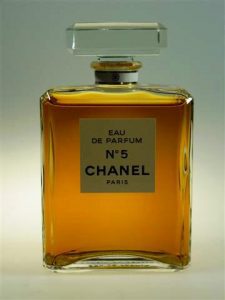Flacon: "Chanel No. 5" - German/German

Fragrant scents were originally created by smoking plants and animal fats. Hence the name perfume, from per fumo - "through smoke".
Glass jars were used very early on to package these enchanting fragrances and prevent them from "evaporating". The Christian Middle Ages forbade the use of scents and the anointing of the dead as a pagan custom of the Jews. In contrast, the trade in healing herbs and perfumed medicines, which were sold in glass ampoules and vials, flourished in the monasteries. With Catherine de Medici, perfume arrived at the courts of Europe in the 16th century - and with it the reawakened sense of beauty and body care.
Perfume is still produced in the southern French town of Grasse today. The former tanner's town has developed into a world-famous perfume centre since Catherine de Medici introduced perfume to Europe. The tanners used perfume to cover up the bad smell of leather.
The production and sale of perfume was in the hands of the apothecaries, haberdashers and glove makers. They decanted precious beauty waters from large bottles into smaller perfume containers. The rich and beautiful used their own flacons, which were romantically playful or geometrically abstract in shape, depending on the fashion. In 1921, a matter-of-factly cool bottle with a completely new, man-made fragrance revolutionised the entire perfume industry: ChanelNo. 5.
To design her first perfume brand, Coco Chanel turned to the company Parfums Rallet, which also worked with the Russian tsars' court perfumer, Ernest Beaux. Chanel wanted her own fragrance, not a mixture and imitation from nature. Beaux presented her with ten numbered perfume samples. Chanel sniffed and tapped on "No. 5". The minimalist crystal glass bottle was another marketing move that made Coco Chanel's perfume the most famous in the world. Marilyn Monroe's famous statement certainly contributed to this:
"To sleep, I only wear a few drops of ChanelNo. 5".
Bottle: "Chanel No. 5" - English

The smoke from burning plants and animal fats originally created fragrant perfumes and this is where the name perfume comes from, from "per fumo," - "through smoke".
Glass containers were used to package these captivating perfumes and prevent them from losing their fragrance from very early on. During the Christian Middle Ages using perfumes and anointing the dead was condemned as a pagan Jewish custom. This meant that the trading of healing herbs and perfumed medicines that were sold in glass vials and small bottles flourished in monasteries. In the 16th century perfume arrived at the European Courts via Katharina de Medici, and with it, a reawakened sense for beauty and personal grooming.
Perfume is still produced today in the town of Grasse in the south of France. Since Katharina de Medici introduced perfume to Europe this once tanner's town has developed into a world-famous perfume centre. The tanners originally used the perfume to cover-up the awful smell of the leather.
The production and sales of perfume was in the hands of the chemists, haberdashery traders and the glove makers. They poured the valuable beauty water out of large bottles into small perfume containers. The rich and beautiful used their own small bottles which, depending on the fashion, were designed in romantic or geometrically abstract shapes. In 1921, a sober, cool-looking bottle revolutionised the whole perfume industry with a novel, artificially produced perfume. It was called ChanelNo. 5.
To get help with the design of her first brand of perfume, Coco Chanel turned to Ernest Beaux of the Parfums Rallet company, who also worked with the court perfumier to the Russian Zsars. Chanel wanted to create her own scent, not a mixture or an imitation of something from nature. Beaux Presented her with 10 numbered perfume samples, which Chanel smelt and selected "No. 5". The minimalist crystal glass bottle was a further marketing strategy, which made Coco Chanel's perfume the most famous brand all over the world. And Marilyn Monroe's comment certainly contributed to its fame:
An interviewer asked her:
"What do you wear to bed?" To which she replied: "ChanelNo. 5".